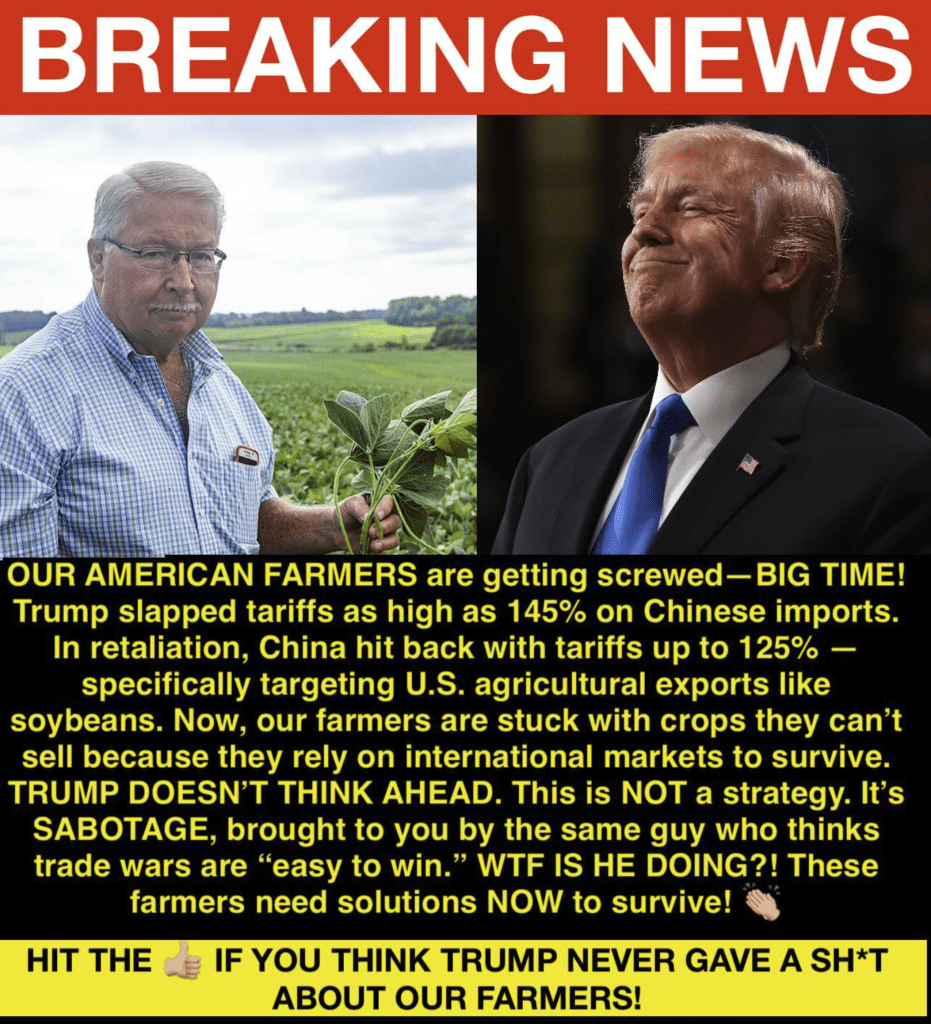In recent years, American farmers have faced unprecedented challenges, from unpredictable weather patterns to fluctuating market prices. However, a new and pressing crisis has emerged—one that threatens the very livelihood of those who feed our nation and the world. The escalating trade war between the United States and China has placed an immense burden on our agricultural communities, with tariffs as high as 145% imposed on Chinese imports by the U.S., and retaliatory tariffs of up to 125% on American agricultural exports like soybeans. This tit-for-tat economic conflict has left farmers struggling to sell their crops, as international markets—once a lifeline for their survival—become increasingly inaccessible. Now, more than ever, it’s time to stand with our farmers, raise awareness about their plight, and demand actionable solutions to ensure their survival.

The Roots of the Crisis: A Trade War Gone Awry
The trade tensions between the U.S. and China began as a strategic move to address long-standing economic imbalances. In 2018, the U.S. administration, under then-President Donald Trump, initiated a series of tariffs on Chinese goods, citing unfair trade practices and intellectual property theft. The goal was to pressure China into negotiating better trade terms and to bring manufacturing jobs back to American soil. While the intentions may have been rooted in economic nationalism, the consequences for American farmers have been devastating.
China, a major buyer of U.S. agricultural products, retaliated swiftly by imposing its own tariffs on American goods, with a particular focus on the agricultural sector. Soybeans—a staple crop for many U.S. farmers—were hit especially hard. Before the trade war, China accounted for nearly 60% of U.S. soybean exports, making it the largest market for American soybean farmers. With tariffs now reaching up to 125%, Chinese buyers have turned to other suppliers, such as Brazil and Argentina, leaving U.S. farmers with surplus crops they cannot sell.
The image of a farmer standing in a field, holding soybean plants with a look of concern, captures the gravity of this situation. Behind the farmer, the headline screams: “OUR AMERICAN FARMERS ARE GETTING SCREWED—BIG TIME!” The accompanying text highlights the core issue: “Trump slapped tariffs as high as 145% on Chinese imports. In retaliation, China hit back with tariffs up to 125%—specifically targeting U.S. agricultural exports like soybeans. Now, our farmers are stuck with crops they can’t sell because they rely on international markets to survive.” This stark reality is a wake-up call for all Americans who value the backbone of our nation’s food supply.
The Human Cost: Farmers on the Brink
The impact of these tariffs goes far beyond economic statistics—it’s deeply personal for the millions of farmers and their families who are struggling to make ends meet. Take, for example, a soybean farmer in Iowa, a state that produces more soybeans than any other in the U.S. Before the trade war, this farmer might have sold 70% of their harvest to China, using the income to pay off loans, invest in equipment, and support their family. Now, with China largely out of the picture, they’re left with silos full of unsold soybeans, plummeting prices, and mounting debt.
The ripple effects are felt across entire communities. Rural towns that depend on agriculture are seeing local businesses shutter as farmers cut back on spending. Equipment dealers, seed suppliers, and even small diners that once thrived on farmers’ patronage are struggling to stay afloat. The emotional toll is just as severe, with reports of rising stress, anxiety, and even suicide rates among farmers who feel powerless in the face of forces beyond their control.
One farmer, speaking anonymously, shared their frustration: “We’ve always been told that hard work pays off. But no matter how hard we work, we can’t sell our crops. The government says trade wars are ‘easy to win,’ but for us, it feels like we’re the ones losing everything.” This sentiment is echoed in the image’s text: “TRUMP DOESN’T THINK AHEAD. This is NOT a strategy, it’s SABOTAGE, brought to you by the same guy who thinks trade wars are ‘easy to win.’ WTF IS HE DOING?!”
While the tone of the image is understandably impassioned, it reflects the raw emotion felt by those who are bearing the brunt of these policies. Farmers are not just fighting for their livelihoods—they’re fighting for their way of life, a legacy that has been passed down through generations.
The Economic Fallout: A Nation at Risk
The trade war’s impact on agriculture has broader implications for the U.S. economy as a whole. Agriculture is a cornerstone of American industry, contributing over $1 trillion annually to the GDP and supporting millions of jobs. When farmers suffer, the entire economy feels the strain. The surplus of unsold crops has driven down prices, reducing farmers’ incomes and forcing many to rely on government subsidies to survive. While programs like the Market Facilitation Program (MFP) have provided some relief, they are a temporary fix for a systemic problem.
Moreover, the loss of international markets poses a long-term threat to America’s position as a global agricultural leader. Countries like Brazil and Argentina are stepping in to fill the gap left by U.S. exports, building relationships with China that may be difficult to reclaim even if the trade war ends. Once these markets are lost, rebuilding trust and market share could take years, if not decades.
The image’s call to action—“THESE FARMERS NEED SOLUTIONS NOW TO SURVIVE!”—underscores the urgency of the situation. Without immediate intervention, we risk not only the livelihoods of individual farmers but also the stability of an industry that is vital to our nation’s food security and economic health.


